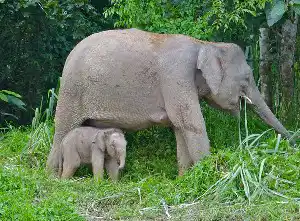One of the most popular animals to see whilst on river and jungle safaris in Sabah is the Borneo pygmy elephant. These unique elephants are the smallest of all Asian elephants and have straighter tusks, longer tails and much larger ears.

Due to their passive and semi-tame nature, Borneo pygmy elephants were thought to descend from a domestic elephant herd that was once given to the Sultan of Sulu many years ago.
This fact is somewhat disputed and further put to rest by a scientific study conducted in 2003, where it was shown that Borneo pygmy elephants are in fact quite genetically distinct to other Asian elephants. These pygmy elephants are actually an entirely unique subspecies known as Elephas Maximus Borneensis as they were proved to be isolated from their cousins on mainland Borneo more than 300,000 years previously.
Although the title pygmy elephant may cause some to think these elephants are small, they are in fact no smaller than their elephant cousins located on Sumatra or on the peninsula. Borneo pygmy elephants can grow up to 3 metres high.
Are the Borneo Pygmy elephants under IUCN Endangered Status?
Borneo Pygmy elephants are an endangered species with only 1500 left in the wild of Sabah. The greatest threat endangering these unique elephants is humankind with the degradation of their natural environment due to land development processes such as logging and palm oil plantation expansions.
Due to their large size, mammals such as the Borneo pygmy elephant require a large environment to forage for their food, and with their natural forest habitats being cut away by humans, it is only a matter of time before conflicts between man and animal give rise to an unhealthy situation.
With a shrinking jungle habitat and increased plantations and crops bringing more humans into their natural habitat, elephants are forced to trample across crops and forage for their food in any areas they are able to access. Also, with the increase of human population, there has been an increase in the number of illegal traps set in these areas for other wildlife. These illegal traps are thought to be the cause of at least 20% of the injuries the Borneo pygmy elephants sustain.
How to see Borneo Pygmy Elephants in the Wild?
Borneo pygmy elephants are most often seen in the north and north eastern areas of Sabah, namely North Kinabatangan, Lower Kinabatangan, Tabin, Ulu Kalumpang Forest Reserve and the central forests of Sabah.
There are a number of sustainable tourist options that focus on this unique pygmy elephant in order to highlight the impact of humankind on these gentle giants as well as raise efforts to protect and conserve their habitat.
Note: Don't miss the must see islands of Sipadan and Mabul (Tawau airport). Please contact us for more information.